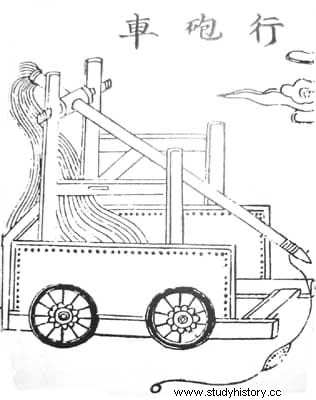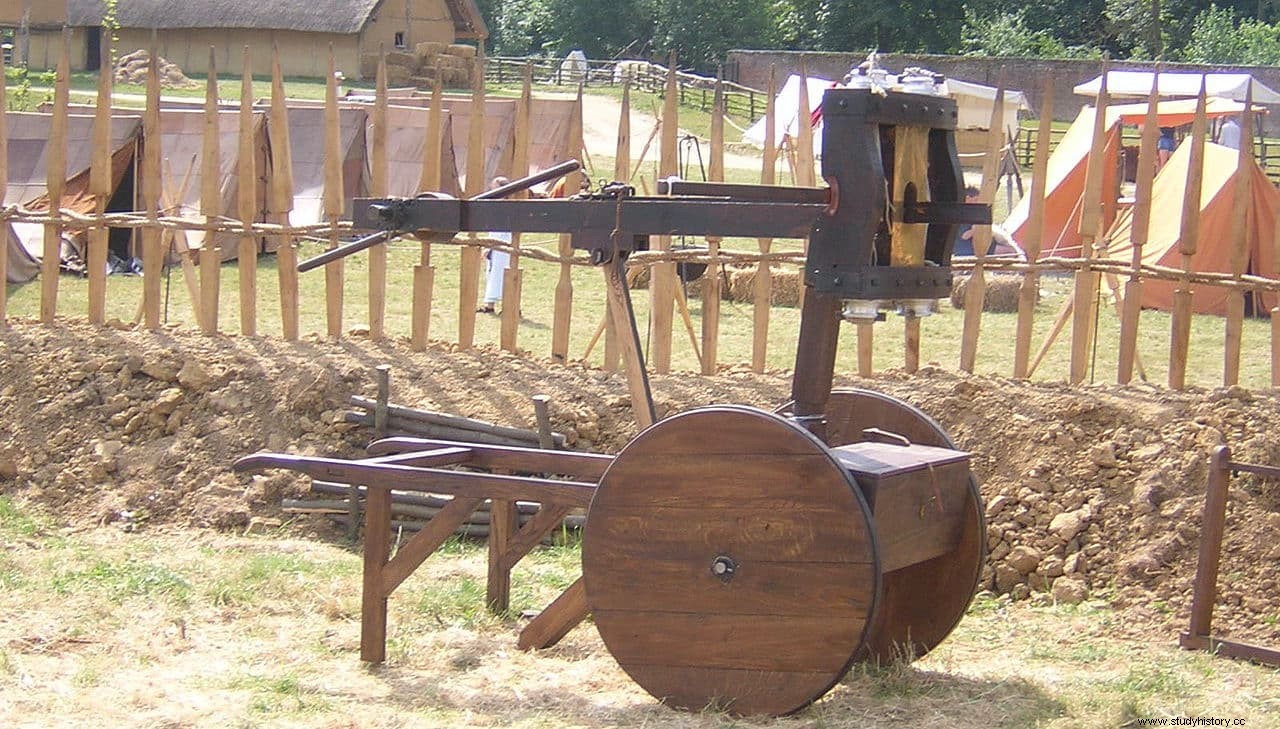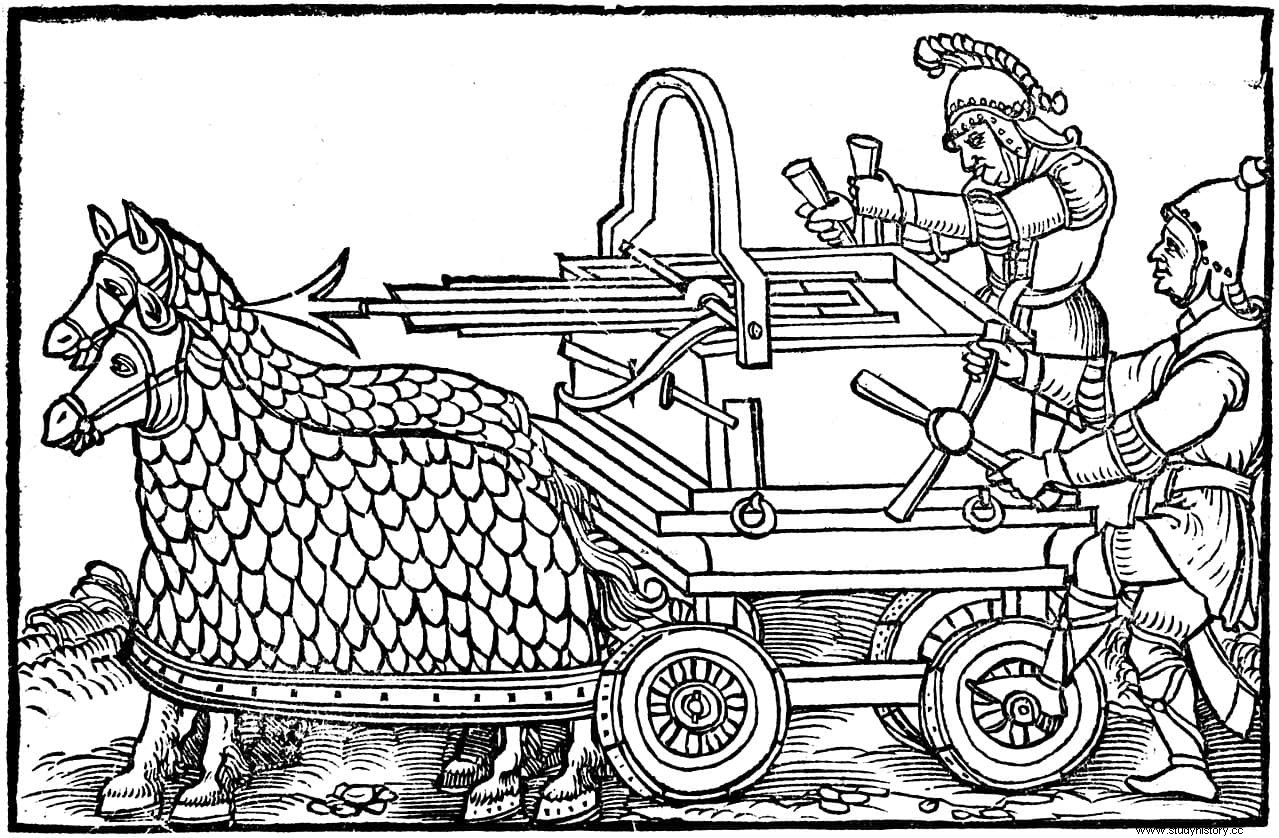Algarradas, ballistas, catapults, onagers, trebuchets... All these projectile-launching weapons were used in Antiquity and continued in force later, in the Middle Ages -some were created specifically in that period-, until the spread of gunpowder and the appearance of artillery made them obsolete. They had two characteristics in common with each other:first, they were used in sieges; second, they were torsion machines, at least the ones mentioned. But there was a third, really curious:the use of human hair in its manufacture.
The torsion system was but an advance of the tension system, simpler and therefore older. The difference was that the latter was limited to tensioning one throwing arm by dragging while the other did so by turning the transmission belt parallel to its axis. The origin of the site mills is difficult to establish. Chinese sources refer to the period of the Warring States, between the 5th and 3rd centuries BC, referring to systems that worked by the lever principle.

In that sense, the chronology would be similar to the western one, which is located in Greece of the fourth century BC, approximately, with the gastrafetes as the original representative:no copy has been preserved but according to the description left by Hero of Alexandria in his work Belopoeica , was a kind of crossbow (large, with a bow of about 4 meters) that the mathematician and inventor Ctesibius would have devised and could launch 18-kilo stones more than 200 meters away.
The first torsion artifact would have appeared at the end of that third century, since an inventory of the Chalcoteca of Athens (one of the buildings of the Acropolis, which served as an armory) reports the presence of torsion machines and auxiliary elements such as bolts, projectiles or hair. Why hair? Because it was one of the components of the strap, providing resistance to the elasticity of the animal tendons that were also used to make the strap. We'll see later.
Philip of Macedon, the father of Alexander the Great, is said to have used twisting machines in his campaigns, though this is likely speculation rather than certainty. In any case, around that time its use spread throughout the Mediterranean, perfecting the manufacturing technique. The Romans did not have such weapons until well into the Republic; Livy tells that Scipio the African seized in New Carthage (the current Spanish Cartagena) 120 large catapults, 281 small ones, 75 ballistae and numerous scorpions, the profusion of it being evident in the Punic Wars.
In fact, the Romans had also reached a high level in siege machinery from the Hellenic models, redesigning them to be removable and easier to transport, the latter factor that gave rise to the birth of the carrobalista (a ballista installed on a chariot, such as as can be seen in the Trajan Column) and the onager (a small catapult with a single arm and equipped with wheels):each legion incorporated a dozen of the former and 55 of the latter (one per cohort), giving rise to the creation of specialists in its management called ballistarii .

Vegetius, Ammianus Marcellinus, Procopius, Diodorus Siculus, Flavius Josephus and the anonymous work De rebus bellicis , among many others, testify to more torsion devices that were added already in the imperial era, without the arrival of the Middle Ages causing a break. Arab, Frankish, and Saxon sources mention ballistae, but it is difficult to say for sure whether that was exactly what they were or other weapons, given the tendency to use the terminology loosely; It is assumed that torsion artifacts coexisted with other tension artifacts.
Not even the treatise that Mardi ibn Ali al-Tarsusi wrote for Saladin in the 12th century and which is considered the most complete on the subject, references more than trebuchets (trebuquets or trebuchets; the first news about them, by the way). Other medieval references also speak of manganas (also called mangonels, catapults capable of launching projectiles 400 meters although without the precision that trebuquets would later achieve), but the usual thing was to mention these machines in a generic way, which makes it impossible to know what models they belong to. treated exactly.

Some 19th century scholars believed that in the Middle Ages there was a technological setback in this field due to the difficulty of finding tendons and metal parts (for example, the protection washers through which the skein passed so as not to fray due to rubbing against the surface). wood), so they would have turned to tension and counterweight devices; This thesis would be supported by the absence of an archaeological record. However, later that century, dissenting voices emerged that deny it, considering that the lack of material evidence is not enough, given the documentaries that, in addition, had illustrations showing its appearance. The debate continues.
Indeed, as they are wooden contraptions, a perishable material, hardly any examples of torsion machines have been preserved beyond some loose parts, precisely those that were made of metal. However, there are some and the first important case was found in 1912 in Ampurias, others appearing in the second half of the 20th century in Gornea (Turkey), Orşova (Romania), Cremona (Italy), Volubilis (Morocco), Hatra (Iraq). ), etc. What there are in the thousands are projectiles, since they used to be made of stone, with different weights between 4.5 and 39 kilos.
It is clear that the structure of the mills was made of wood, reinforced at key points by metal brackets. But there was also the skein, which was the differentiating element of the torsion system with respect to the tension system. It consisted of a series of threads wound in a spiral around the frames, remaining taut. When the weapon had to be loaded, this skein was rotated by means of cranks on both sides, tightening it even more and lowering the launching arm, whose base is held between said strands. When shooting, a force greater than that of the tension system was achieved, which was based on a simpler principle:that of the bow.

We said before that this skein was sometimes made with animal tendons, especially from horses, and sometimes with human hair, fundamentally female for the obvious reason that it was longer. There it depended on taste, because if the Greek Heron of Alexandria and the Roman Vegetius agreed in preferring the sinew, Vitruvius opted for the hair, often horsehair but sometimes human if the circumstances were desperate.
The best tendons were considered to be those from the legs of a horse or deer and those from the neck of an ox. According to some researchers, it was a very elastic material, something that was preserved by spreading olive oil or fat; but at the same time it presented great resistance, much greater than that of a wooden beam, for example, and without being affected by the high Mediterranean temperatures. It is estimated that the average life of a tendon was between 8 and 10 years.
The skeins of human hair are known to be related to Rome, where in the early days women donated their hair in extreme situations (later the Carthaginians also did), something that symbolized their sacrifice because wearing short hair was considered a sign of neglect and indecency (it had to be worn long but collected), as described by some classical sources such as Virgil. Likewise, as in the previous case, they were spread to protect them and could be combined with tendons to give cohesion to the whole.
